
FeedARead.com publishing, 2021; ISBN: 1803022280. 284 pp.
Acronyms. Initialisms. Descriptors. Labels. Some stick around. Others come and go. ‘UFO’ seems to have had greater longevity than ‘Flying Saucer’ but even that seems to have been supplanted in recent years by ‘UAP’: ‘Unidentified Aerial Phenomena.’ And given that some of the temporarily-labelled whatever-they-ares have been sighted submerged, emerging from the ground, or landed, it’s tempting to conclude that UAP, too, shall pass. And then there’ll be something else.
All this being said, there seems something distinctly apt about the mutability of the initialisms and labels used to designate UFOs. For the UFOs (or UAPs, or whatever) also seem unable – or unwilling – to stick with any one, particular, shape or form. As one witness quoted by Spyridon Bailey put it: ‘The large object was continually, slowly, changing shape, in the way that a swarm of bees might alter its appearance.’
Paradoxically, the UFOs’ mutability seems to have been the one real constant throughout their decades-long history of appearances, disappearances, and everything in between, and this, in turn, is one of the pieces of evidence that leads well-known Orthodox writer Father Spyridon Bailey to his conclusion that they are not simply ‘nuts and bolts’ spaceships piloted by aliens from other planets. Instead, for him, they should better be defined as demons whose shape-shifting is just one in a series of tricks they have consistently deployed to deceive the unwary.
That Orthodoxy has long been aware of the sinister mutability of aerial principalities and powers is one of Bailey’s key contentions in this interesting study. Or rather, two studies, because in addition to presenting a response to the UFO enigma from the perspective of the Orthodox Church The UFO Deception is also nothing less than an extended overview of the entire UFO ‘narrative’, encompassing its history, key figures, an examination of the multifaceted nature of the phenomenon and – throughout – an assessment of its implications for our understanding of ourselves as beings inhabiting a world that is more than the sum total of its physical parts. And herein lies the potential appeal and interest of Bailey’s book to CFPSS members: its overriding contention that in engaging with the UFO mystery we are engaging with something spiritual.
Despite his seemingly encyclopaedic knowledge of the history of UFOlogy, Father Bailey is apparently unaware that other researchers outside of the boundaries of the Orthodox Church have made many of the same points over the last few decades. Celebrated British UFO researchers Charles Bowen and Gordon Creighton, for example, both editors of the late lamented British-based Flying Saucer Review, held comparable views at times within their UFOlogical ‘careers’ and there have even been UFO research groups such as the UK’s Christian UFO Research Association that have historically made the spiritual nature of the UFO enigma a key focus of their enquiries. Further afield, UFO researchers such as Jacques Vallee and John Keel have hinted at the non-straightforwardly-physical and, in Keel’s case, demonological aspects of the UFO phenomenon in a series of wide-ranging and acclaimed studies. Bailey is aware, at least, of these, and shows himself particularly impressed with aspects of Vallee’s work whilst criticising him for his inability – or unwillingness – to fully appreciate the negative and harmful aspects of UFO activity.
It is to these aspects that Bailey gives the final word, referring to other Orthodox theologians such as Father Seraphim Rose in his analysis. For Bailey, ‘UFOs are actually demons’ and, moreover, many of the world’s governments are aware of this, thereby adding to the deception. The demonic nature of the phenomenon, moreover, means that UFOs cannot be approached in a straightforwardly neutral, objective, and empirical way; requiring, instead, the rich resources of Orthodox theology to be revealed for what they are: malevolent beings, shape-shifters capable of assuming both physical and non-physical forms, roaming through the air to unsettle and confound the unwary. This, in fact, for Bailey, is their mission: ‘to threaten, frighten, confuse and mislead.’
Whilst in many respects unoriginal, this central thesis of The UFO Deception explains much: from the mutability of the phenomenon through to its often frightening and bizarre aspects. It was disappointing, though, to discover several shortfalls in the study overall. For example: the Orthodox perspective, whilst clear, could have been developed further. Only in later chapters was it explored in any depth, with the lion’s share of the book given over to the overview of UFOlogical history. Whilst fine for the beginner, this has been done much better elsewhere: for example in the voluminous studies produced by Jerome Clark and others. Indeed, at various points I found myself wondering who The UFO Deception was actually written for. The various typos jarred, too – ‘Keel’ often misspelled as ‘Kiel’, for example – whilst the lack of an index made navigation and cross-referencing more difficult than it should have been.
In recent years my own understanding of UFOs has moved significantly in the direction broadly suggested by Father Bailey. Not as things which only Orthodoxy can understand, however, but as shape-shifting ‘trickster’ intelligences with both physical and non-physical aspects. That both parapsychology and theology have a significant part to play in exploring such things seems to me a given.
This review first appeared in Fellowship Review, No 257, Summer 2023, pp. 33 – 5